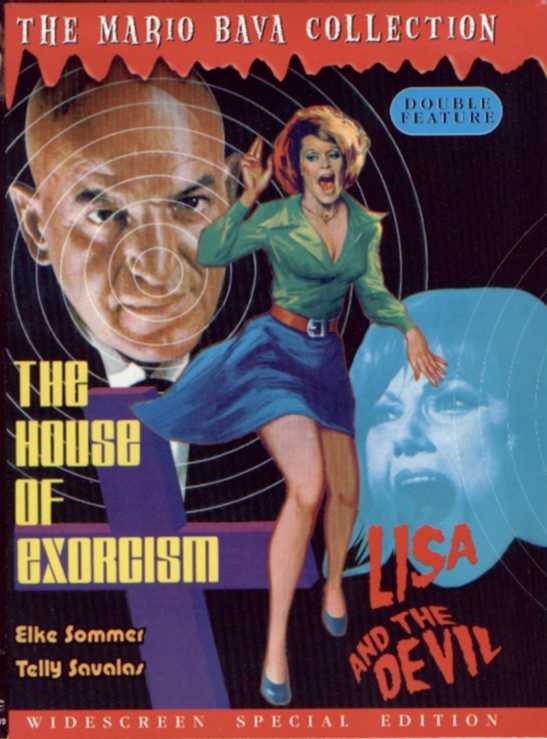 LISA
AND THE DEVIL (1973)/HOUSE OF EXORCISM (1975)
LISA
AND THE DEVIL (1973)/HOUSE OF EXORCISM (1975)Director: Mario Bava
Image Entertainment
 LISA
AND THE DEVIL (1973)/HOUSE OF EXORCISM (1975)
LISA
AND THE DEVIL (1973)/HOUSE OF EXORCISM (1975)This installment in Image Entertainment's continuing "Mario Bava Collection" bestows us with the maestro's most passionate project, LISA AND THE DEVIL as a special edition coupled with it's bastardized incarnation, HOUSE OF EXORCISM. Both films are available separately (retailing at $24.99), but at $39.99 and packed with extras, the double feature is a must-have disc for Bava aficionados, myself included.
LISA AND THE DEVIL tells the tale of a beautiful young tourist (Elke Sommer) who witnesses an unusual mural of the devil (a cartoonish portrait of Telly Savalas with pointed ears) while in Toledo, Spain. She strays from her tour bus and ends up in a dream-like world of nightmarish events and surreal imagery. Her journey takes her to a villa where Savalas (as a lollipop-sucking butler who turns out to be Satan) observes and plays host to night of death and decay.
Bava's film is cluttered with the usual gothic settings, but the story is more convoluted and somewhat poetic as far as horror films are concerned. The Satan character functions as a puppetmaster for the other characters as they all suffer violent deaths around him (mannequins--a favorite prop of Bava's--are utilized as a kind of metaphor for dead souls). As a highly erotic ghost story displaying relationships between the living and the dead, LISA AND THE DEVIL is fueled by some of Bava's most powerful camera work.
The film was very well received at Cannes, but despite this and a distribution offer from AIP (that the producer turned down), the indescribable, slow-paced film was deemed unsellable and was shelved. Alas, several years later new footage was shot, bringing back Sommer as Lisa, and HOUSE OF EXORCISM was born. In the new footage, the character has become possessed after her stay at the villa, so new scenes show Sommer spewing green fluid and tiny toads from her swollen mouth, while screaming dialog like "Don't break my balls, priest!" to exorcising Father Michael (Robert Alda). In the wake of half a dozen other EXORCIST rip-offs, HOUSE OF EXORCISM was a huge success and grossed millions.
The surprise bonus on this set is the HOUSE OF EXORCISM commentary by Sommer and producer Alfred Leone. While Sommer's comments are limited to five or six fond remembrances, Leone sheds light on the production of both projects, answering questions that have puzzled fans for years. For example, Leone explains that Bava did indeed direct much of the new HOUSE footage (with his son Lamberto as assistant), but didn't have anything to do with the scenes of vulgarity and nudity (these scenes where orchestrated by Leone himself). Bava was very religious and even tried to persuade the actors not to participate in these scenes! As Leone conveys, he had a great relationship with Bava, so comprises were made and after a brief falling out, Bava (who ran out before the film was edited) was satisfied with the outcome and allowed his name back on the credits (it had been credited to "Mickey Lion").
HOUSE might be trash, but its clever use of footage from LISA does not stem from the Jerry Warren or Al Adamson school of idiotic inserting. Leone's commentary guides the viewer through how the new story was devised and how they were able to intelligently and coherently blend the footage together (look for a Telly Savalas double which Leone distinguishes by the scar on the back of his bald head). HOUSE contains more gore and nudity that was shot for LISA but not used in the final cut of Bava's original. One scene which was never used in either film and is isolated as bonus, has Sylva Koscina and Gabriele Tinti in a rather surprisingly softcore romp!
The quality on both films is quite acceptable, but LISA appears to be a bit grainy, especially in darker scenes, and the color is somewhat dull. HOUSE is sharper with better color and detail, but it suffers from minor speckles on the print, whereas LISA's source material is in much better shape. Blacks are solid in both transfers and the mono sound is okay, but somewhat on the low side. Leone also mentioned that there is a Spanish version of LISA that runs 6 or 7 minutes longer, but it's presence is yet surface.
Other extras include an "incomplete" trailer for LISA (it looks pretty complete to me) which also contains brief commentary by Leone. There are also two trailers for HOUSE; first is the longer, more exploitive one from Peppercorn-Wormser, and a shorter tease trailer that appears to be British, comparing it to THE EXORCIST and THE OMEN. There is also a photo and poster art gallery, a bio/filmography of Bava, filmographies for Sommer and Savalas, as well as liner notes by Tim Lucus (the man responsible for bringing the Bava Collection to life on DVD) that use many quotes from Leone found within the accompanying commentary.
I think that this double feature was an ingenious idea on behalf of Image. Why they also released the films separately is beyond me (hell, more is better than less so I'm not complaining). Again, I highly suggest the double-disc, as Leone's commentary is so insightful (I only wished that they had employed him to comment on the BARON BLOOD DVD). (George R. Reis)